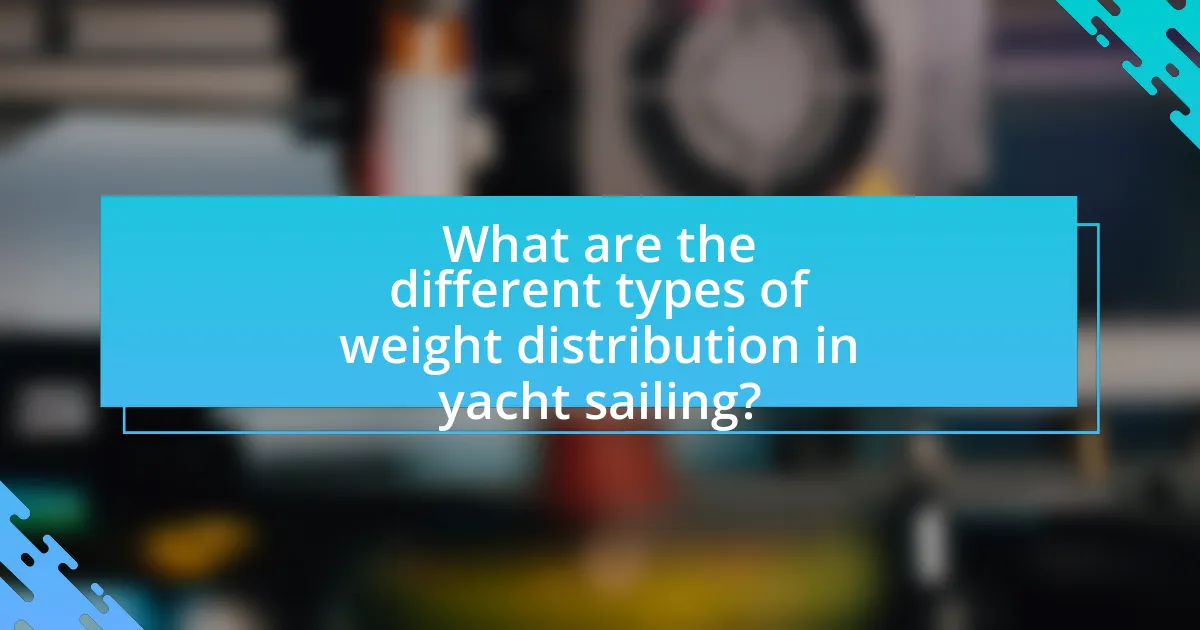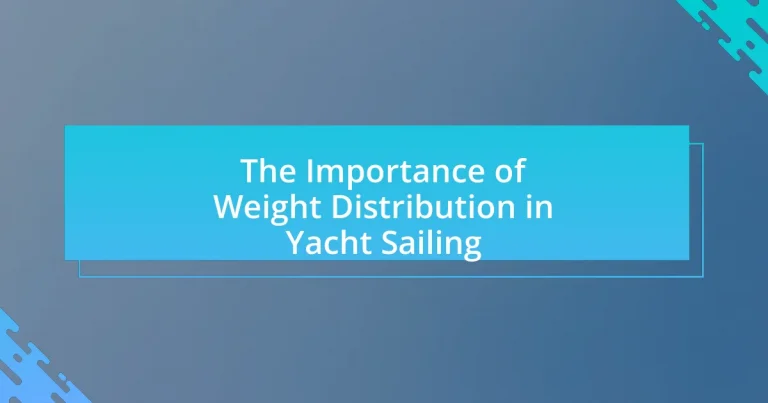Weight distribution is a critical factor in yacht sailing, significantly influencing balance, stability, and overall performance. Proper weight management affects the yacht’s center of gravity, helping to prevent capsizing and enhancing sailing efficiency by up to 20%. Key elements such as the placement of equipment, crew positioning, and the yacht’s design play vital roles in achieving optimal weight distribution. This article explores the importance of weight distribution, its impact on safety and performance, and best practices for sailors to ensure effective weight management while navigating various sailing conditions. Additionally, it discusses tools and techniques for assessing and optimizing weight distribution to improve sailing efficiency.

What is the Importance of Weight Distribution in Yacht Sailing?
Weight distribution in yacht sailing is crucial for maintaining balance, stability, and performance. Proper weight distribution affects the yacht’s center of gravity and helps prevent capsizing, especially in strong winds or rough seas. For instance, placing weight low and centrally can enhance stability, while uneven weight can lead to excessive heel, reducing control and speed. Studies have shown that optimal weight distribution can improve sailing efficiency by up to 20%, demonstrating its significant impact on overall sailing performance.
How does weight distribution affect yacht performance?
Weight distribution significantly affects yacht performance by influencing stability, speed, and maneuverability. Proper weight distribution ensures that the yacht maintains an optimal center of gravity, which enhances stability and reduces the risk of capsizing. For instance, when weight is evenly distributed, the yacht can sail more efficiently, allowing for better speed and responsiveness to wind conditions. Conversely, uneven weight distribution can lead to excessive heel, causing drag and reducing overall performance. Studies have shown that yachts with balanced weight distribution can achieve up to 15% better speed compared to those with poor weight management.
What are the key factors influencing weight distribution on a yacht?
The key factors influencing weight distribution on a yacht include the placement of equipment, the arrangement of crew and passengers, and the design of the yacht itself. Equipment such as sails, engines, and tanks must be strategically positioned to maintain balance and stability, as improper placement can lead to capsizing or reduced performance. The arrangement of crew and passengers affects the center of gravity; for instance, having too many people on one side can cause the yacht to heel excessively. Additionally, the yacht’s design, including hull shape and weight distribution systems, plays a crucial role in how weight is managed during sailing. These factors collectively ensure optimal performance and safety while navigating.
How does weight distribution impact stability and balance?
Weight distribution significantly impacts stability and balance by determining the center of gravity and the righting moment of a vessel. When weight is evenly distributed, a yacht maintains a lower center of gravity, enhancing stability and reducing the likelihood of capsizing. Conversely, uneven weight distribution can raise the center of gravity, leading to increased heel and decreased balance, which can compromise safety. Research indicates that optimal weight distribution can improve a yacht’s performance by allowing for better control and responsiveness in various sailing conditions.
Why is weight distribution critical for safety in yacht sailing?
Weight distribution is critical for safety in yacht sailing because it directly affects the vessel’s stability and balance. Proper weight distribution ensures that the yacht maintains an even keel, reducing the risk of capsizing and improving maneuverability. When weight is unevenly distributed, it can lead to excessive heel, which compromises the yacht’s ability to sail efficiently and safely. Studies have shown that a well-balanced yacht can handle adverse weather conditions better, as it remains more responsive to steering and less prone to losing control. Therefore, maintaining optimal weight distribution is essential for safe sailing practices.
What risks are associated with improper weight distribution?
Improper weight distribution in yacht sailing poses significant risks, including capsizing, reduced maneuverability, and increased strain on the vessel’s structure. Capsizing occurs when weight is unevenly distributed, leading to an imbalance that can cause the yacht to tip over, particularly in rough waters. Reduced maneuverability results from improper weight placement, making it difficult for the crew to control the yacht effectively, especially during turns or in adverse weather conditions. Additionally, uneven weight can lead to increased stress on the hull and rigging, potentially causing structural damage over time. These risks highlight the critical importance of maintaining proper weight distribution for safe and efficient sailing.
How can weight distribution prevent capsizing?
Weight distribution prevents capsizing by ensuring that a yacht’s center of gravity remains low and balanced. When weight is evenly distributed, the yacht maintains stability, reducing the risk of tipping over in response to wind or waves. For instance, placing heavier items in the lower sections of the yacht and evenly spacing lighter items helps to lower the center of gravity, which enhances stability. Research indicates that a well-balanced yacht can withstand greater forces without capsizing, as evidenced by the design principles used in competitive sailing vessels, which prioritize optimal weight placement to enhance performance and safety.

What are the different types of weight distribution in yacht sailing?
The different types of weight distribution in yacht sailing include fore and aft distribution, beam distribution, and overall weight management. Fore and aft distribution refers to the placement of weight along the length of the yacht, which affects trim and balance; for example, moving weight forward can improve performance in certain wind conditions. Beam distribution involves the lateral placement of weight across the yacht, impacting stability and heel; an even distribution helps maintain an upright position while sailing. Overall weight management encompasses the total weight carried by the yacht, which influences speed and maneuverability; lighter yachts generally perform better in racing conditions. These types of weight distribution are crucial for optimizing sailing performance and ensuring safety on the water.
How do different weight distribution methods affect sailing efficiency?
Different weight distribution methods significantly affect sailing efficiency by influencing the boat’s balance, speed, and maneuverability. For instance, placing weight low and centrally enhances stability, reducing the risk of capsizing and allowing for better control in rough waters. Conversely, shifting weight to the sides can increase heel, which may improve speed in certain conditions but can also lead to loss of control if overdone. Research indicates that optimal weight distribution can improve a yacht’s performance by up to 20%, as it allows for better sail trim and reduces drag. Therefore, effective weight management is crucial for maximizing sailing efficiency.
What is the role of ballast in weight distribution?
Ballast plays a crucial role in weight distribution by lowering a yacht’s center of gravity, enhancing stability and preventing capsizing. By adding weight, typically in the form of water or heavy materials, ballast counteracts the forces of wind and waves, allowing the yacht to maintain an upright position. This is essential for safe sailing, as a well-distributed ballast helps to balance the yacht, improving its performance and maneuverability in various sea conditions. Historical data shows that yachts with optimized ballast ratios experience significantly better handling and reduced risk of tipping over, underscoring the importance of effective weight distribution in yacht design and operation.
How does crew positioning influence weight distribution?
Crew positioning directly influences weight distribution by determining the balance and stability of the yacht. When crew members are strategically placed, they can shift the center of gravity, which affects how the yacht interacts with wind and water. For instance, moving crew members to the windward side can counteract heeling, enhancing stability and performance. Research indicates that optimal crew positioning can improve sailing efficiency by up to 20%, as it allows for better control of the yacht’s trim and reduces drag. This demonstrates that effective weight distribution through crew positioning is crucial for maximizing sailing performance and safety.
What are the best practices for achieving optimal weight distribution?
The best practices for achieving optimal weight distribution in yacht sailing include positioning heavy equipment and crew members low and centrally within the vessel. This practice lowers the center of gravity, enhancing stability and reducing the risk of capsizing. Additionally, evenly distributing weight across the boat helps maintain balance, which is crucial for effective sail performance and maneuverability. Research indicates that a well-balanced yacht can improve speed and responsiveness, as evidenced by studies conducted by the International Sailing Federation, which highlight the correlation between weight distribution and sailing efficiency.
How can sailors assess their yacht’s weight distribution?
Sailors can assess their yacht’s weight distribution by using a combination of onboard scales and visual inspections. Onboard scales measure the weight at various points, allowing sailors to identify how weight is distributed across the yacht. Additionally, visual inspections of the yacht’s trim and balance while underway provide insights into weight distribution, as an uneven keel or excessive heel indicates improper weight placement. Accurate assessment is crucial because improper weight distribution can affect stability and performance, leading to safety risks and inefficient sailing.
What adjustments can be made for varying sailing conditions?
Adjustments for varying sailing conditions include altering weight distribution, adjusting sail trim, and modifying course direction. Weight distribution affects a yacht’s stability and performance; shifting weight forward or aft can enhance control in different wind conditions. For example, in strong winds, moving weight to the center or lower can reduce heeling and improve balance. Adjusting sail trim, such as easing or tightening the sails, optimizes performance based on wind strength and direction. Additionally, changing course direction to sail at an optimal angle to the wind can enhance speed and stability. These adjustments are essential for maintaining control and maximizing efficiency in diverse sailing conditions.

What tools and techniques can assist in managing weight distribution?
Tools and techniques that assist in managing weight distribution in yacht sailing include the use of ballast systems, adjustable rigging, and strategic placement of equipment and crew. Ballast systems, such as water ballast or lead weights, help lower the center of gravity, enhancing stability and performance. Adjustable rigging allows sailors to modify sail shape and tension, which can influence how weight is balanced across the yacht. Additionally, strategically placing equipment and crew based on their weight and the yacht’s design can optimize weight distribution, improving handling and speed. These methods are supported by sailing performance studies, which indicate that proper weight distribution can significantly affect a yacht’s speed and maneuverability.
How can technology aid in weight distribution analysis?
Technology aids in weight distribution analysis by utilizing advanced software and sensors to accurately measure and visualize weight placement on yachts. For instance, load cells and pressure sensors can be installed at various points on a yacht to gather real-time data on weight distribution, which is then analyzed using specialized software to create detailed reports and visualizations. This data-driven approach allows sailors to optimize their vessel’s balance and performance, enhancing safety and efficiency during sailing. Studies have shown that precise weight distribution can significantly improve a yacht’s handling characteristics, making technology an essential tool in modern yacht sailing.
What software or apps are available for weight distribution planning?
Software and apps available for weight distribution planning in yacht sailing include SailWeight, YachtWeight, and Trimble’s Ag Software. SailWeight allows users to input various weights and positions to optimize balance, while YachtWeight provides a user-friendly interface for calculating weight distribution and stability. Trimble’s Ag Software offers advanced features for agricultural applications but can also be adapted for marine weight distribution planning. These tools are designed to enhance sailing performance by ensuring optimal weight distribution, which is crucial for stability and maneuverability on the water.
How can physical tools help in measuring weight distribution?
Physical tools such as load cells, scales, and weight distribution gauges are essential for accurately measuring weight distribution on a yacht. These tools provide precise data on how weight is distributed across different sections of the vessel, which is critical for maintaining balance and stability during sailing. For instance, load cells can measure the weight at various points, allowing sailors to adjust cargo placement to optimize performance. Studies have shown that improper weight distribution can lead to capsizing or reduced speed, emphasizing the importance of these measurements in ensuring safety and efficiency on the water.
What practical tips can improve weight distribution on a yacht?
To improve weight distribution on a yacht, evenly distribute heavy items such as fuel, water, and equipment throughout the vessel. This practice enhances stability and performance by lowering the center of gravity and preventing excessive heel. For instance, placing heavy gear in the lower sections of the yacht and balancing it port and starboard can significantly reduce the risk of capsizing. Additionally, regularly checking and adjusting the weight distribution based on the number of passengers and their gear ensures optimal sailing conditions. Proper weight management is crucial, as uneven distribution can lead to poor handling and increased fuel consumption.
How can sailors effectively load and unload gear for optimal balance?
Sailors can effectively load and unload gear for optimal balance by distributing weight evenly across the vessel. This involves placing heavier items low and centrally to lower the center of gravity, while lighter items can be positioned higher and towards the ends of the boat. Research indicates that maintaining a balanced weight distribution enhances stability and performance, reducing the risk of capsizing. For instance, the American Sailing Association emphasizes that improper weight distribution can lead to poor handling and increased drag, which negatively impacts sailing efficiency.
What common mistakes should be avoided regarding weight distribution?
Common mistakes to avoid regarding weight distribution in yacht sailing include placing too much weight on one side, which can lead to capsizing, and failing to adjust weight based on wind conditions, resulting in poor balance and performance. Additionally, neglecting to secure loose items can cause shifting weight during sailing, affecting stability. Proper weight distribution is crucial for maintaining optimal sailing performance and safety, as uneven weight can significantly impact a yacht’s handling and speed.

















